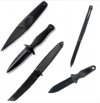- H1
EDGE RETENTION: 2 CORROSION RESISTANCE: 9 EASE OF SHARPENING: 8
H1 steel from Japan’s Myodo Metals is basically the ultimate in corrosion resistance and essentially does not rust. The epitome of true stainless steel. Naturally, this comes at a price and that price is edge retention which is relatively poor. So, while excellent for diving it’s a non-starter for most EDC use. Very expensive stuff.
GEARJUNKIE ON H1 STEEL: "This is a nitrogen steel that is extremely corrosion resistant – so much so that it’s used in knives designed to go in salt water, among the most difficult conditions knives are used in. It’s not a particularly great cutter, being poor at retaining an edge. But it’s lightyears ahead of the alternatives, specifically titanium-bladed knives."
- LC 200N STEEL
GEARJUNKIE ON LC 200N STEEL: "Also known as Z-Finit, Zapp produces this steel in America. It was originally developed for use as ball bearing steel by NASA. The unique process used to make LC 200N results in a fine-grain structure. LC 200N is an elite performer, with high hardness, high toughness, and off-the-charts corrosion resistance. This is a virtually stain-proof steel suitable for all sorts of aquatic environments. Spyderco is the only production company using this steel, though Michael Gavik of Gavko knives produced a number of customs in LC 200N."
- Nitro-V
58-60 HRC
GEARJUNKIE ON Nitro V STEEL: "In nitrogen steels, nitrogen is used as the iron hardener instead of carbon, thus limiting the possibility of rusting. Developed by New Jersey Steel Baron, Nitro V is a non-powder steel marketed as an enhanced version of AEB-L. Nitro V, as its name indicates, adds nitrogen to AEB-L’s formula to make the steel even more corrosion resistant. It has enough water-fighting properties that it can be used in marine environments."
- SM-100 AKA HIPTiNite, Great write up in Blade Magazine, March 2016. Powdered metal(PM) technology, is NOT steel, it is 60% nickel and 40% titanium. 60HRC or better with good edge retention and wear resistance. Can be left in saltwater for 50yrs and show no corrosion. For one knife expect high labor and material costs as it takes up to 6 belts ($40+ in belts alone) to shape one of these knives, as they are very hard and cannot be easily ground or machined. Material is being used by Strider Knives.
Contact: Duane Dwyer, Strider Knives, 1050-D Linda Vista Drive, San Marcos CA 92078 or call 760-471-8275
GEARJUNKIE ON SM100 STEEL: "The old rule in steels used to be: “Corrosion resistance, toughness, or hardness – choose two.” But SM100 (the trade name for Nitinol 60) threw that out the window when introduced to the cutlery world. It is very hard, tough, and corrosion resistant. It’s called memory metal because heat can get it to revert back to a previous shape. In fact, it’s not technically a steel at all, as it uses titanium and nickel. Steel is a combination of iron and carbon with other elements. But SM100 is not widely available, hard to heat treat and grind, and exceptionally expensive. No mainstream companies use SM100, and the niche makers that do usually charge more than $1,000 for knives with SM100 blades. But if you want to know what the coolest blade material is, for my money, SM100 is it."




